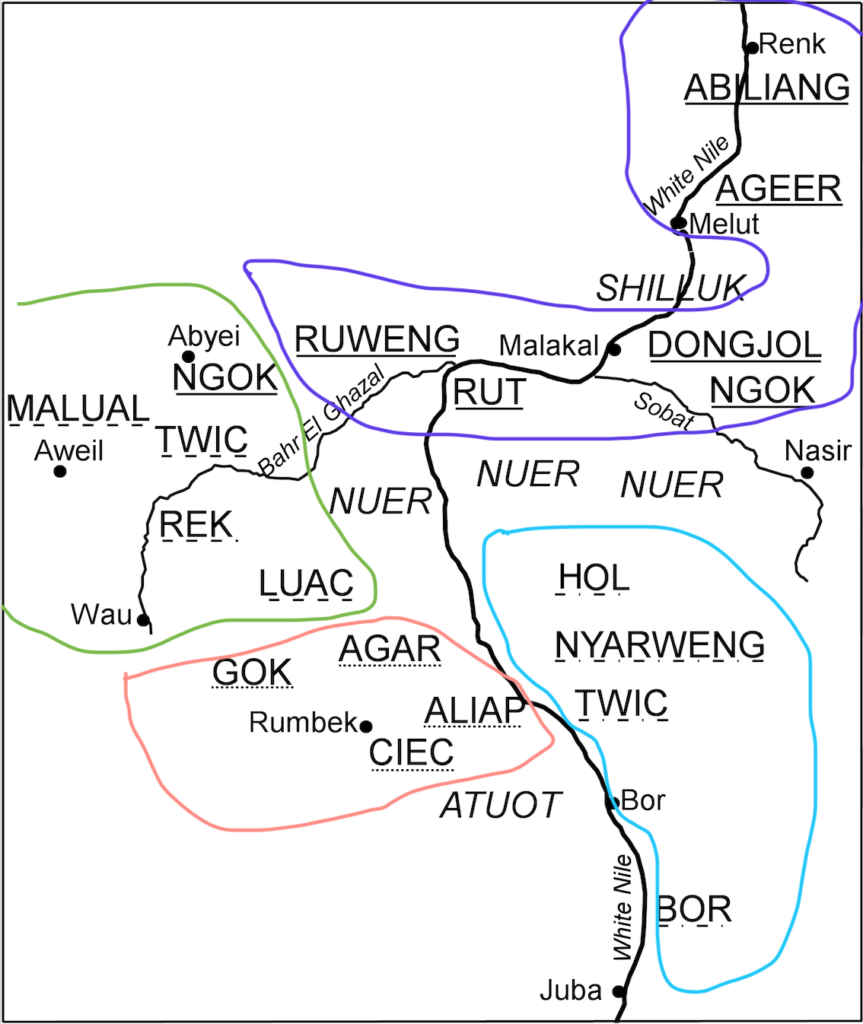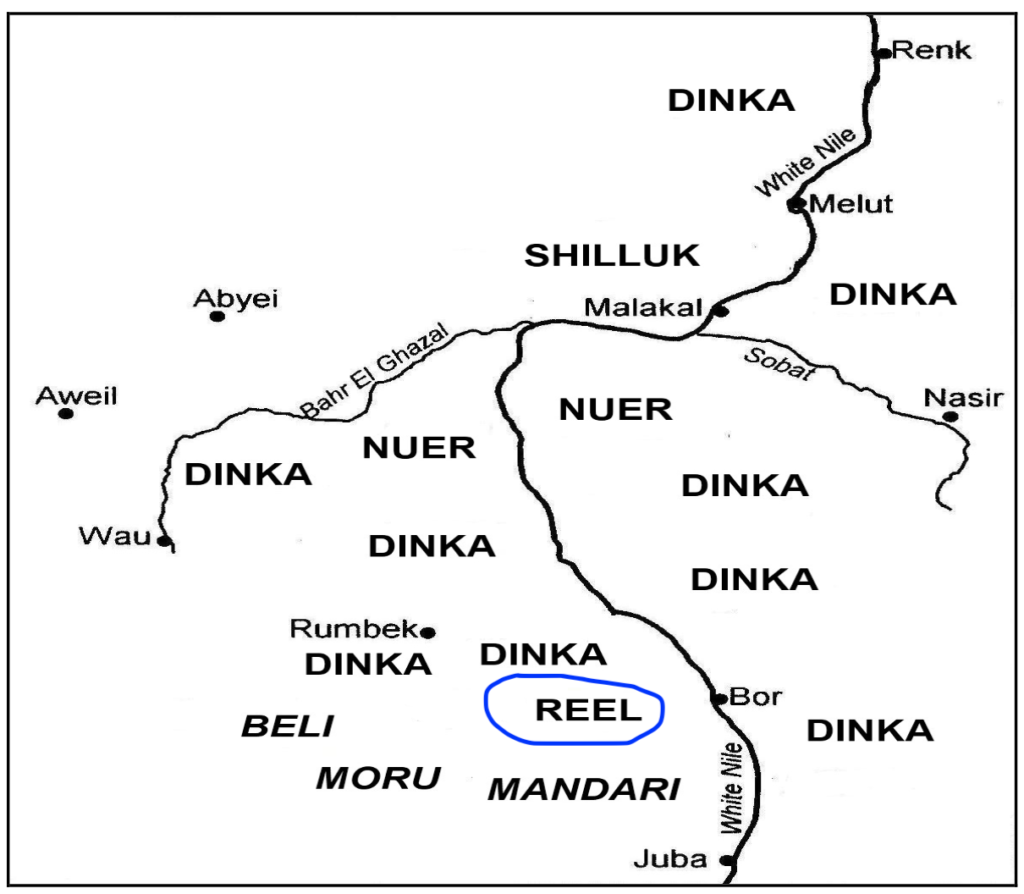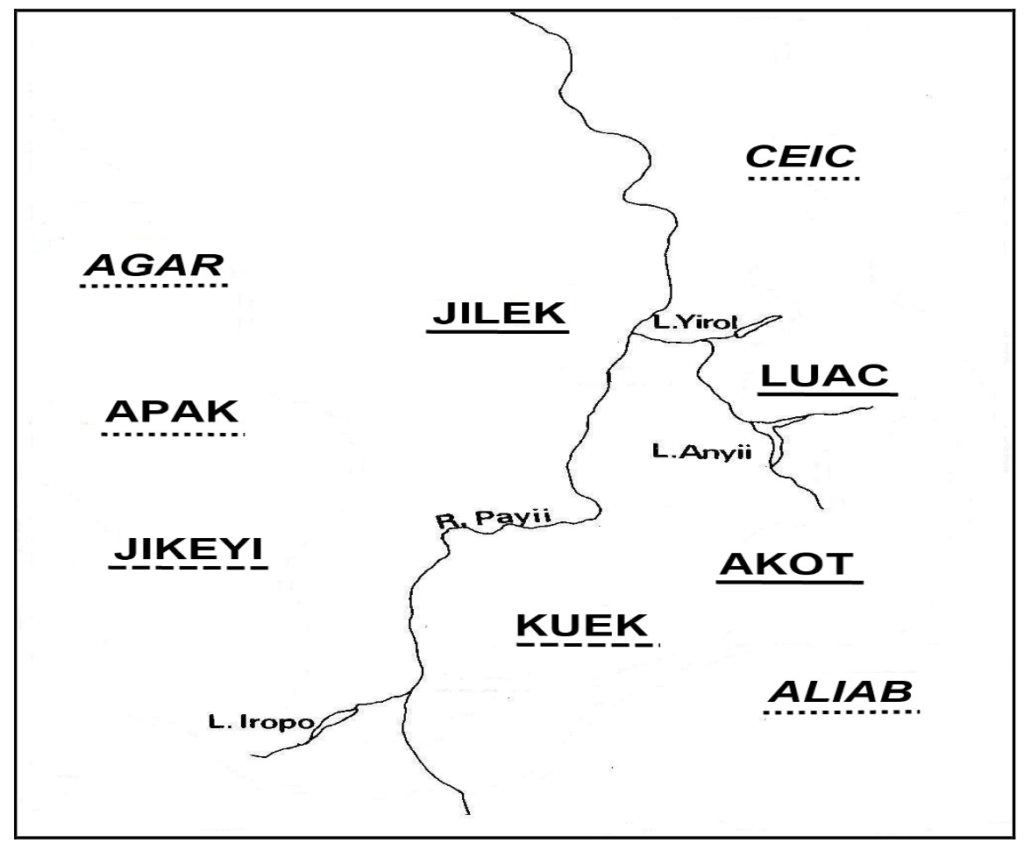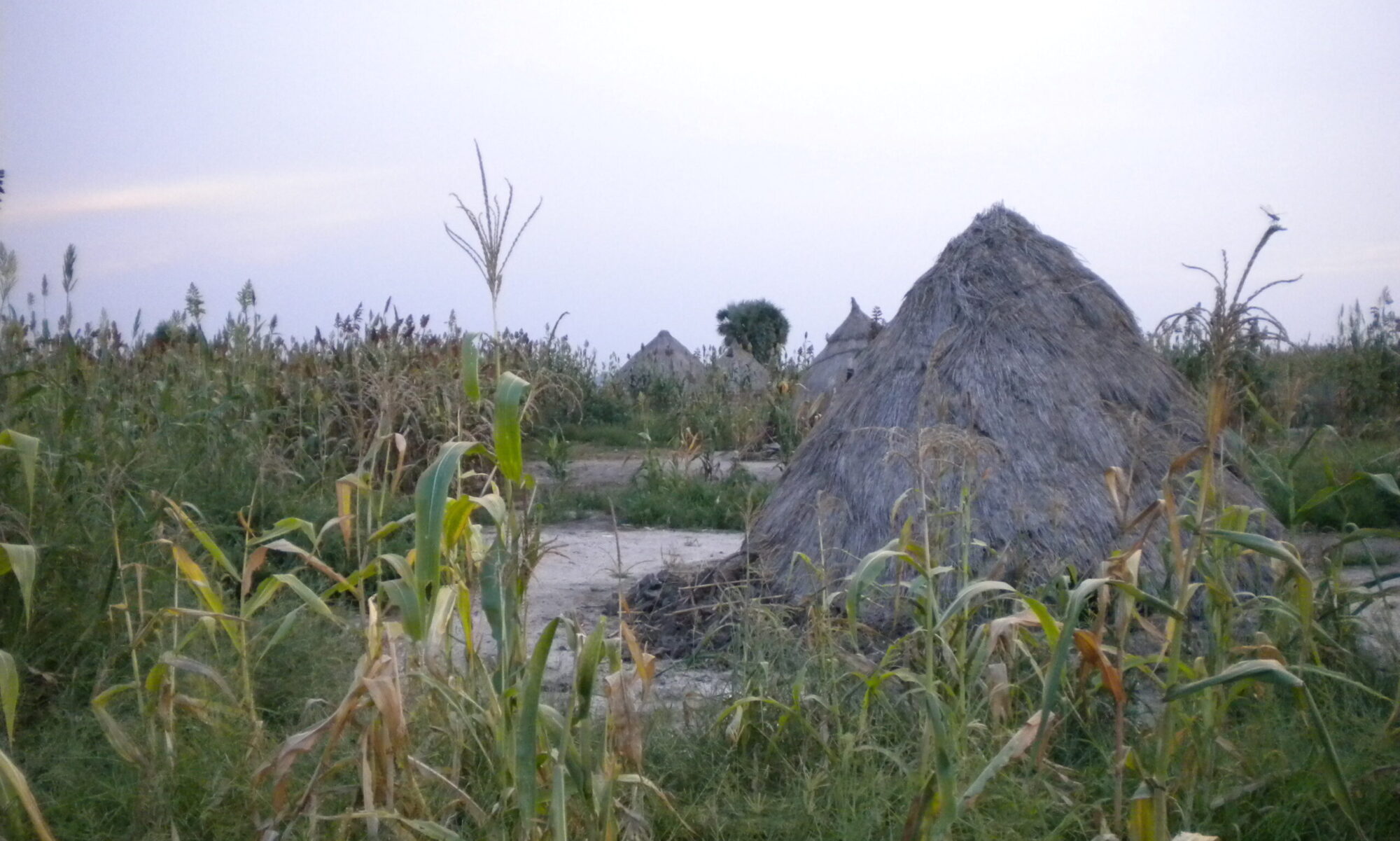Dinka
Dinka is a West Nilotic language of the Dinka-Nuer subgroup, spoken in South Sudan by approximately 1.3 million people (Ethnologue). Dinka can be separated into four dialect clusters: Rek, Agar, Padang, and Bor. A fifth cluster, Athoc, is sometimes mentioned, but is one of numerous non-linguistic sub-divisions of Bor Dinka. Speakers call their language Thuɔŋjäŋ.

The Bor cluster (Hol, Nyarweng, Twic East, and Bor South) is bordered by the White Nile to the west and Nuer territory to the North. The Padang cluster, which has both a northern and a western branch, is bordered by Nuer territory to the south, and Rek Dinka and Shilluk territory to the west. Agar Dinka is bordered by the White Nile to the east, Rek Dinka to the north, and Atuot (Reel, see below) to the South; Rek Dinka is bordered by Padang Dinka, Nuer, and Shilluk to the east and Agar Dinka to the south. In this map, Rek is outlined in green, Padang in purple, Bor in Blue, and Agar in orange, though it should be noted that these outlines are only meant to represent the groupings of dialect clusters and not any geographical information regarding borders.
The Dinka, like other communities in South Sudan, are traditionally pastoralists, and cattle are a profoundly important aspect of life and culture. The Dinka are also often noted for their height, and are sometimes estimated to be one of the tallest ethnic groups in the world. Today many Dinka have left South Sudan, and large communities can be found abroad, in neighbouring East African countries (such as Kenya and Uganda), as well as in the United States and Australia, the latter of which has over 12,000 speakers.
Nuer
Nuer is a West Nilotic language of the Dinka-Nuer subgroup. It is spoken in South Sudan and in Ethiopia by approximately over 2.5 million people that refer to themselves as Naath and are known to the outside world as the Nuer; they call their language Thok Naath. The Nuer people belong to eight sections (or clans). These are Bul, Lek, Jikany, Jegai, Adok, Nyong, Ador, Gawaar and Lou.
Within Nuer, two clusters of dialects can be distinguished: Western and Eastern. The speakers of the Western and Eastern varieties are separated by a natural boundary – the White Nile. Western Nuer is spoken in South Sudan to the west of White Nile by members of seven Nuer sections: Bul, Lek, Jegai, Adok, Nyong, Ador and Jikany. It is also known as Bentiu after the main town in the territory where the speakers live. Eastern Nuer is spoken to the east of the White Nile in South Sudan and in the Gambella region of Ethiopia. It comprises of four dialects: the Gawaar dialect, the Lou dialect, the Jikany dialect spoken in the east of South Sudan (also known as Nasir), and the Ethiopian Jikany dialect.
The Nuer are traditionally pastoralists and cattle play an important role in every aspect of traditional life. In addition, they rely on seasonal horticulture and fishing for their living. In modern times many South Sudanese Nuer have immigrated abroad to escape persistent unrest in their native territories. Large Nuer settlements can be found in the U.S.A., Australia and in East Africa.

Reel

Reel is a West Nilotic language of the Dinka-Nuer subgroup. It is spoken by approximately 90,000 people in South Sudan around the towns of Yirol and Mapuordit. The self-reference name for the speakers of Reel is Reel, and they call their language Thok Reel. Outside of their community, they are known as Atuot (or Atwot). This name is also used as a self-reference by a group that comprises of the Reel and Apak people. The speakers of Reel comprise five of the six sections of the Atuot – Jilek, Luac, Jikeyi, Kuek and Akot. The sixth section, Apak, speaks Thong Apak which is a dialect of Dinka.
Reel language has been referred to in literature as Atuot, Thok Reel or Reel. The speakers of Reel distinguish two dialects: Thok Reel Cieng Luai and Thok Reel Cieng Nhyam. Thok Reel Cieng Luai (lit. ‘language of the homeland of the Luac Reel’) is spoken by the Jilek, Luac and Akot sections. These three sections live along the north-eastern frontiers of the Atuotland, bordering Aliab, Ciec and Agar Dinka. Thok Reel Cieng Nhyam (lit. ‘language of the homeland of the Reel of the front side’) is spoken by the Kuek and Jikeyi sections. The two sections live around the Mapuordit area – along the south-western boundaries of the Atuotland. They border Mundari, Moru and Jur Bel (the speakers of Beli). The difference between the two dialects is reported to be purely lexical. There is a fair amount of lexical borrowing from Dinka by the speakers of Thok Reel Cieng Luai. Thok Reel Cieng Nhyam, by contrast, has retained many of the Nuer lexical items that are no longer found in Thok Reel Cieng Luai.

Around 80% of the Atuot are bilingual in Reel and Dinka. The 20% of the monolinguals come from the older generation of the more conservative Kuek and Jikeyi sections. Many native speakers of Reel are also fluent in Sudanese Arabic and English.
The speakers of Reel are thought to be a Nuer section which migrated into the Dinka territory some 500 years ago (Burton 1987).
Shilluk
The Shilluk language (called Cøllø by speakers, [IPA: cɔlːɔ]) is spoken in the region around the town of Malakal, near the confluence of the Sobat River with the White Nile. The language has several hundred thousand speakers, which makes it, in terms of number of speakers, one of the bigger language communities in South Sudan, after Dinka and Nuer. Agriculture plays a bigger economic role in the Shilluk region than in the Dinka and Nuer communities. As for their language, the Shilluk people themselves distinguish three dialects; from South to North they are Lwak, Gar, and Mwomo. The sound system of Shilluk presents a rich system of suprasegmental contrasts, with three levels of vowel length and nine distinctive tone categories. Voice quality also plays a role, as a correlate of the Advanced Tongue Root contrast, which is realised through a combination of vowel height (primary correlate) and voice quality (secondary correlate). A salient feature of Shilluk morphosyntax is its complex morphology, in particular in relation to verbs: these display morphological marking for voice (subject voice vs. object voice vs. applicative voice), evidentiality (evidential past vs. non-evidential past), and spatial orientation (movement towards speaker vs. movement away from speaker), among others. Verbs and nouns alike mark relations between heads and dependents on the head, rather than on the dependent. This means that a noun is morphologically marked not for its relation to the verb, its head, but rather for its relation to the dependents within its own domain. For example, a noun is inflected when it is modified by an adjective.
Thuri
Thuri is the westernmost of the West Nilotic languages. Thuri is the endonym; the exonym is Shat or Jur Shat. Like Shilluk it is part of the Northern Lwoo subgroup. It is spoken in Western and Northern Bahr El Ghazal States within South Sudan. The southern end, it is spoken in some villages on the road between Wau and Dem Zubeir, specifically Kuru, Abul and Korgana. At the northern end, it is spoken in villages between Raja and Aweil, including Acano. There are no earlier sources on Thuri. Given so, our on-going research aims to produce documentary materials (narratives); determine its grammatical properties, so as to situate relative to the language mostly closely related to it, which is Luwo.
